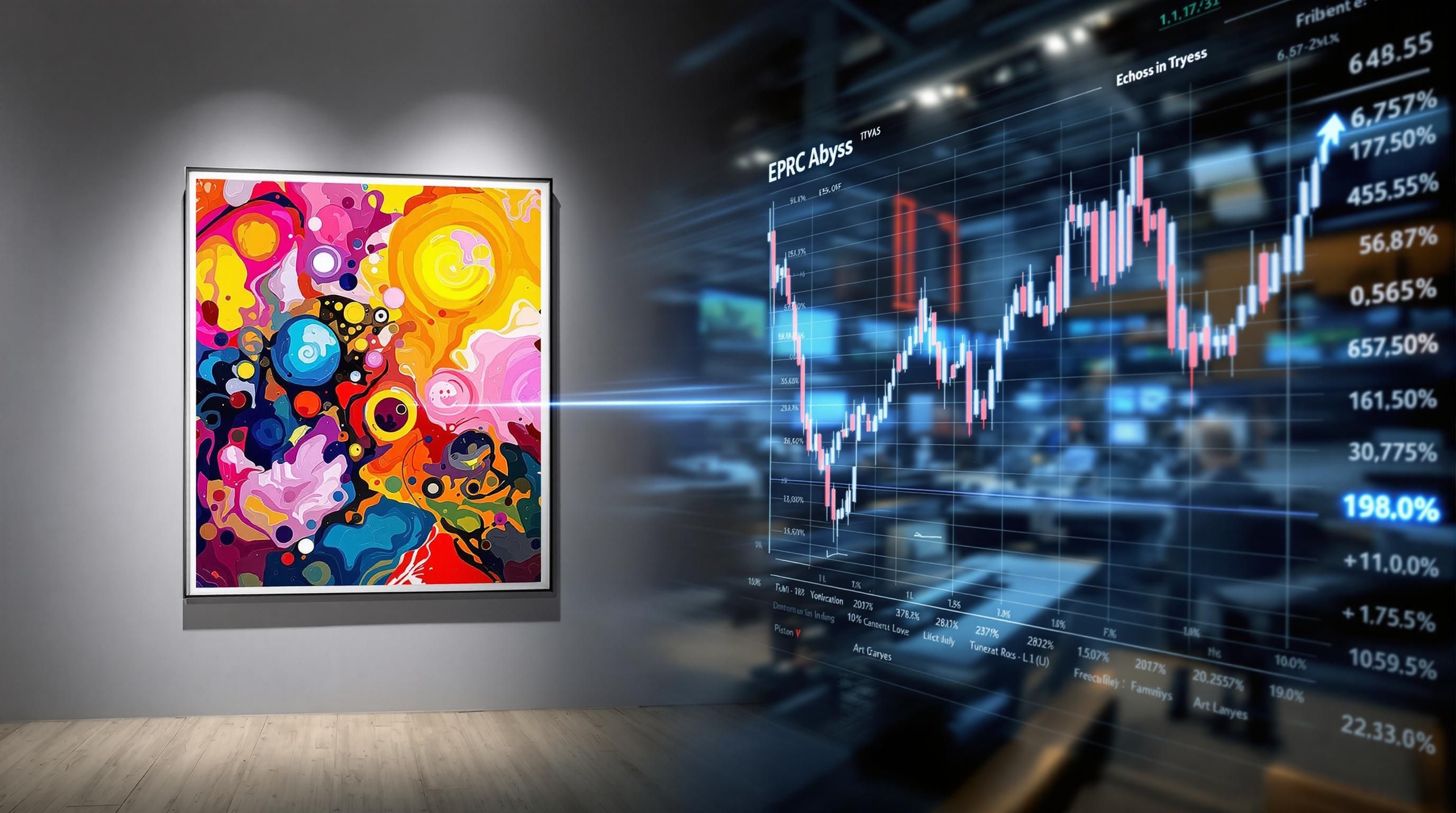Understanding Art Valuation: More Than Just a Price Tag
What Is Art Valuation?
When you look at a painting, sculpture, or other artwork, you’re not just seeing an object—you’re witnessing the culmination of artistic skill, historical context, cultural significance, and market forces. Art valuation attempts to quantify these elements into a monetary figure that represents what a willing buyer might pay a willing seller in an open market.
According to art market experts, proper valuation requires understanding both objective and subjective factors. As noted by the Corporate Finance Institute, “Art valuation is a part of financial valuation that deals with the estimation of the fair market value of works of art.”
The Art Market at a Glance
Unlike other assets, artworks are unique, with complex value determinants that extend beyond material composition or production costs. This makes art valuation both an art and a science, requiring expertise in artistic movements, market trends, authentication methods, and economic principles.
The Different Types of Art Valuations
Purpose-Driven Valuations
Understanding the purpose of your art valuation is crucial as it fundamentally affects the approach and outcome. According to Artsy, “An appraisal is a professional assessment of an artwork’s value that results in a formal document.”
Here are the primary types of art valuations:
Insurance Valuations
Insurance valuations determine the amount you should insure your artwork for in case of damage, theft, or loss. These typically represent the retail replacement value—what it would cost to purchase a comparable piece in the current market.
Key characteristics:
- Often higher than fair market value
- Takes into account retail prices and replacement costs
- Usually requires periodic updates (every 3-5 years)
- May include restoration costs if damaged
Fair Market Value Appraisals
Fair Market Value (FMV) represents what a willing buyer would pay a willing seller in an open market when neither is under pressure to act. This type of valuation is common for:
- Tax purposes (donations, estate taxes)
- Divorces and estate divisions
- Private sales between collectors
The IRS requires qualified appraisals for art donations valued over $5,000, with specific guidelines for what constitutes a valid appraisal.
Auction Estimates
When consigning artwork to auction houses, specialists provide high and low estimates indicating the expected sale range. These are not formal appraisals but professional opinions based on recent comparable sales.
Liquidation Value
This represents what artwork might fetch in a forced or accelerated sale situation, typically resulting in lower values than FMV. Used for bankruptcy proceedings or situations requiring quick sales.
Types of Art Valuations
Different valuation approaches and their typical purposes
</tbody>
</table>
Key Factors Influencing Art Value
What Determines an Artwork's Worth?
Artist Recognition and Reputation
The artist’s standing in the art world significantly impacts valuation. Factors include:
- Historical importance and influence
- Critical reception and exhibition history
- Academic attention and literature mentions
- Career stage when artwork was created
- Consistent market presence
As noted by Artwork Archive: “Value is determined based on comparing subject property to sole comparable property – a piece of art by the same artist or one of similar quality.”
Provenance and Authenticity
Provenance—the documented history of an artwork’s ownership—can dramatically affect value. Strong provenance:
- Verifies authenticity
- Connects artwork to important collectors or institutions
- Creates historical narrative and significance
- Helps prevent fraud and forgery issues
Authentication from recognized experts can increase value by 30-50%, while questionable authenticity can render even beautiful works nearly worthless.
Condition and Conservation
The physical state of an artwork is crucial to its valuation:
- Original condition typically commands premium prices
- Professional restoration may recover or maintain value
- Damage, fading, or deterioration significantly reduces worth
- Conservation reports provide transparency about interventions
Rarity and Scarcity
Limited supply drives up prices, influenced by:
- Size of the artist’s oeuvre (total body of work)
- Number of similar works in circulation
- Unique characteristics or experimental techniques
- Artist’s lifespan and production period
Size, Medium, and Subject Matter
Physical characteristics affect both market demand and value:
- Larger works typically command higher prices (though market preferences change)
- Certain media are more valued for specific artists
- Subject matter aligns with artist’s iconic themes
- Materials and execution quality
Artwork Condition Assessment
Factors that art appraisers examine when evaluating physical condition
- Surface integrity (no cracks, flaking, or losses)
- Color vibrancy and fading assessment
- Previous restoration or conservation work
- Structural stability of supports (canvas, panel, etc.)
- Frame condition and originality
- Signs of environmental damage (water, sunlight, mold)
- Signature integrity and authenticity
Current Market Trends and Economic Factors
Art values fluctuate based on broader market dynamics:
- Collector preferences and fashion cycles
- Economic conditions affecting luxury spending
- Gallery and dealer representation quality
- International demand and collecting patterns
- Exhibition inclusion and institutional recognition
According to Artscapy, “Valuation is an objective assessment of an artwork’s market worth, also referred to as Fair Market Value (FMV), Market Value (MV) and Market Value (MV).”
Professional Appraisal Methods
How Professionals Value Art

Comparable Sales Approach
The most common valuation method involves analyzing recent sales of similar artworks by the same artist or comparable artists. Professionals consider:
- Sales from the past 3-5 years
- Artworks of similar size, medium, period, and quality
- Venue of sales (auction, gallery, private)
- Adjustments for condition differences or market changes
According to the Smithsonian American Art Museum, “Appraisers are trained specialists who work for a fee. They evaluate your piece and give you a written statement of its value.”
Income Approach
For art with income-generating potential (like commissioned reproductions), appraisers may calculate the present value of future income streams. This applies primarily to commercial art or works with licensing potential.
Cost Approach
Mainly used for contemporary art, this method considers production costs plus artist’s premium. Factors include:
- Materials and production expenses
- Artist’s time and labor costs
- Gallery markups and commissions
- Artist’s market standing and demand
Expert Opinion and Connoisseurship
Beyond data-driven approaches, qualified appraisers apply subjective expertise:
- Visual analysis of technique and execution
- Assessment of aesthetic quality and significance
- Understanding of historical context and importance
- Knowledge of specific artist’s market dynamics
Evolution of Art Valuation Practices
- Pre-1900s
Connoisseurship Era
Art valuation relied almost exclusively on expert opinion and aesthetic judgments from recognized authorities, with limited market data available. - 1950s-1970s
Auction Record Tracking
Development of more systematic auction result documentation, creating the first comprehensive price databases for comparative analysis. - 1980s-1990s
Professional Standards
Establishment of formal appraisal organizations with standardized methodologies and ethical guidelines for art valuation. - 2000s-2010s
Digital Revolution
Online databases and algorithms transform art valuation with unprecedented access to sales data and market analytics. - Present
Hybrid Approach
Modern art valuation combines digital tools, market data analytics, traditional connoisseurship, and emerging technologies like AI image recognition.
Formal Appraisal Documents
Professional appraisals typically include:
- Detailed artwork description and measurements
- Photographs from multiple angles
- Artist biography and market analysis
- Comparable sales data with analysis
- Valuation conclusion with methodology explanation
- Appraiser’s credentials and certification
- Statement of intended use and limiting conditions
Platforms like FindArtInfo provide access to auction records and sales data that can assist with preliminary valuations, though they don’t replace professional appraisals.
DIY Valuation: First Steps Before Hiring a Professional
Preliminary Assessment Techniques
Authentication Basics
Start by confirming the authenticity of your artwork:
- Examine signatures, dates, and any inscriptions
- Look for certificates of authenticity, gallery labels, or receipts
- Research the artist’s typical style, techniques, and subjects
- Check for studio stamps, edition numbers, or other markings
According to Austin Galleries, determining if your artwork is a painting or print is one of the first crucial steps in valuation.
Documentation Collection
Gather all available documentation about your artwork:
- Original purchase receipts and certificates
- Exhibition history and literature references
- Previous appraisals or condition reports
- Photographs documenting the work over time
- Letters, emails, or other correspondence about the piece
Online Research Resources
Several online tools can help with preliminary research:
- MutualArt offers online art appraisal services starting at $36
- Auction house archives (Sotheby’s, Christie’s, Bonhams)
- Artist-specific foundations or catalogue raisonné
- Museum collection databases
- Gallery websites representing the artist
When to Seek Professional Help
Consider professional appraisal when:
- The artwork appears valuable or by a recognized artist
- You need valuation for insurance, donation, or estate purposes
- Planning to sell or make significant investment decisions
- Settling estates or dividing assets
- Updating insurance coverage
As the Fine Art Trade Guild advises: “If you suspect that your picture is valuable, take it to a specialist fine art auctioneer, such as Bonham’s, Christie’s or Sotheby’s.”
Art Appraisal Service Costs
Typical fees for professional art valuation services (2023)
| Category | Price | Notes |
|---|---|---|
| Insurance Valuation | Replacement Value | Insurance coverage, high-value collections |
| Fair Market Value | Current Market Price | Tax donations, estate planning, divorce |
| Auction Estimate | Expected Sale Range | Consignments, potential sale planning |
| Liquidation Value | Quick-Sale Price | Bankruptcy, forced sales, immediate cash needs |
</tbody>
</table>
Special Considerations for Different Art Forms
Valuing Different Art Mediums
Paintings and Works on Canvas
Paintings typically represent the highest-value segment of the art market:
- Original oils and acrylics command premium prices
- Factors include canvas condition, stretcher quality, and frame originality
- Restoration history significantly impacts value
- Signature placement and authenticity are crucial
Prints and Multiples
Editions and reproductions require specialized knowledge:
- Edition size and number within series affects value (lower numbers typically worth more)
- Original artist prints worth more than posthumous editions
- Authentication marks, chop marks, and paper quality are essential
- Printing technique impacts value (lithographs, etchings, serigraphs)
According to valuation experts, print values can vary dramatically based on edition details and condition factors that are unique to works on paper.
Sculpture and Three-Dimensional Works
Sculptural works present unique valuation challenges:
- Material quality and durability (bronze, marble, wood)
- Casting quality for bronze works
- Edition size for cast sculptures
- Patina condition and consistency
- Base originality and condition
Photography
Photographic works have specific valuation considerations:
- Print type and process (silver gelatin, chromogenic, digital)
- Edition size and number
- Print date (vintage vs. modern prints)
- Signature and authentication marks
- Paper quality and condition
Digital and New Media Art
Emerging art forms present evolving valuation challenges:
- NFT (Non-Fungible Token) association and blockchain verification
- Hardware and software requirements for display
- Technological obsolescence factors
- Artist’s digital signature or authentication method
- Transfer of ownership rights and display licenses
The Valuation Process: What to Expect
Working with Professional Appraisers
Finding Qualified Appraisers
Look for appraisers with:
- Membership in professional organizations (American Society of Appraisers, International Society of Appraisers)
- Specialized knowledge in your artwork’s period, style, or medium
- Compliance with Uniform Standards of Professional Appraisal Practice (USPAP)
- Clear fee structure and service description
- No conflicts of interest (not simultaneously dealing in similar art)
The Appraisal Appointment
A typical appraisal visit includes:
- Physical examination of artwork
- Detailed photography and measurement
- Discussion of provenance and history
- Review of existing documentation
- Preliminary observations and next steps
Appraisal Report Components
A comprehensive appraisal report should contain:
- Detailed description and condition assessment
- Artwork history and provenance information
- Market analysis and comparable sales data
- Clear statement of value with effective date
- Methodology explanation and limiting conditions
- Appraiser’s qualifications and certification
Questions to Ask Your Appraiser
Ensure you understand the process by asking:
- What is your specific expertise with this type of artwork?
- What valuation approach will you use?
- How long will the appraisal process take?
- What documentation do you need from me?
- How often should this appraisal be updated?
- Are there any conflicts of interest I should know about?
Art Valuation for Tax and Legal Purposes
Meeting Legal Requirements
IRS Requirements for Art Donations
For art donations valued over $5,000, the IRS requires:
- Qualified appraisal by a qualified appraiser
- Appraisal no earlier than 60 days before donation
- Appraisal must include specific information (detailed in IRS guidelines)
- Form 8283 (Noncash Charitable Contributions) filed with tax return
- Additional requirements for items valued over $20,000
The IRS Art Appraisal Services notes: “A complete description of the object, indicating the size, subject matter, medium, name of the artist (or culture), and approximate date of creation” is essential for a qualified appraisal.
Estate Tax Valuations
For estate tax purposes:
- Valuations must reflect fair market value at date of death
- Alternative valuation date (6 months after death) may be used
- Blockage discount may apply for large collections
- Qualified appraisers familiar with estate tax requirements are essential
Insurance Appraisals
For proper insurance coverage:
- Replacement value typically higher than fair market value
- Regular updates recommended (every 3-5 years)
- Detailed condition reports and photographs
- Special riders may be needed for high-value items
Legal Disputes and Divorce Settlements
In legal contexts:
- Independent appraisers often required by both parties
- Court may appoint its own expert appraiser
- Valuation date crucial (varies by jurisdiction)
- Methodology must be defensible under examination
Market Trends Affecting Art Values
Understanding Market Dynamics
Economic Factors
Broader economic conditions affect art market liquidity:
- Interest rates and investment alternatives
- Wealth concentration and high-net-worth population
- Currency fluctuations for international collectors
- Tax policies affecting art investments
Collecting Trends
Evolving collector preferences impact specific market segments:
- Growing interest in previously undervalued artists and movements
- Increasing diversity in artists receiving market attention
- Rising prominence of art from non-Western traditions
- Shifting medium preferences (digital vs. traditional)
Technology Impact
Digital transformation is reshaping art valuation:
- Online sales platforms expanding market access
- Blockchain for authentication and provenance tracking
- AI and machine learning for market data analysis
- NFTs creating new markets for digital originals
Environmental and Ethical Considerations
Emerging concerns affecting collector decisions:
- Sustainability of materials and production methods
- Ethical acquisition history (especially for antiquities)
- Repatriation debates affecting museum-quality works
- Artist resale rights and equity considerations
Resources for Further Research
Valuable Art Valuation Resources
Artwork Archive: What Art Collectors Need to Know About Art Valuation
Comprehensive guide covering fundamental valuation concepts for collectors, including detailed explanations of different valuation approaches.
Smithsonian American Art Museum: How Much Is Your Object Worth?
Expert guidance from one of America's leading art institutions on understanding artwork value and working with professional appraisers.
FindArtInfo: Free Art Price Database
Searchable database of auction results to help with preliminary research on comparable sales and artist market history.
MutualArt: Online Art Appraisal Service
Professional online appraisal service with access to expert evaluators and comprehensive market data for quick valuations.
IRS: Art Appraisal Services
Official IRS guidelines for art appraisals related to tax deductions, including requirements for qualified appraisals and appraisers.
Corporate Finance Institute: Art Valuation Overview
Financial perspective on art as an asset class, including valuation methodologies and market analysis frameworks.
Wikipedia: Art Valuation
Comprehensive overview of art valuation history, methodologies, and considerations with extensive references for further research.
Common Questions About Art Valuation
Frequently Asked Questions About Art Valuation
How do you determine the value of an artwork?
Determining artwork value involves several steps:
- Identify whether the work is an original painting or print
- Research the artist’s market history and significance
- Examine the provenance (ownership history)
- Assess the physical condition
- Consider size, subject matter, and period within the artist’s career
- Research comparable sales of similar works
- Account for current market conditions and trends
For valuable pieces, professional appraisal is recommended, as experts have access to comprehensive sales databases and specialized knowledge of specific artists and periods.
How much does it cost to get art professionally valued?
Professional art appraisal costs vary based on several factors:
- Basic online valuation services start around $35-150
- In-person appraisals for single items typically range from $250-500
- Additional items in a collection often cost $75-125 each
- Complex or high-value artworks may cost $500-1,500 to appraise
- Specialized appraisals for legal purposes may be charged hourly ($350-500/hour)
Many galleries offer certificates of valuation for artworks purchased directly from them, sometimes at reduced rates for existing clients. For example, David Hart Galleries charges $250 for the first artwork and $125 for additional pieces, with discounts for gallery clients.
What is the difference between an art valuation and an appraisal?
While often used interchangeably, there are technical differences:Art Valuation:
- More general term for estimating artwork value
- Can be informal or preliminary
- May not result in a formal document
- Not necessarily performed by certified professionals
- Often not legally binding
Art Appraisal:
- Formal process performed by qualified professionals
- Results in an official document with specific value conclusion
- Follows established methodologies and standards
- May be legally binding for certain purposes
- Often required for insurance, tax, and legal matters
As noted by Artsy, "While an appraisal is a formal process that results in a certificate or judgment and can be legally binding, valuations are more akin to approximations, which can be based on opinions from multiple sources and are not legally binding."
How often should I get my artwork appraised?
The recommended frequency for art appraisals depends on several factors:
- For insurance purposes: Every 3-5 years
- After significant market changes affecting the artist’s values
- Following major events in the artist’s career (retrospectives, death, etc.)
- When the artwork undergoes conservation or restoration
- If planning to sell, donate, or transfer ownership
- When estate planning or updating wills
Art markets can be volatile, with values fluctuating based on changing tastes, artist recognition, and economic conditions. Regular appraisal updates ensure your insurance coverage remains adequate and your understanding of your collection’s value stays current.
Can I get my art valued online for free?
While completely free professional art valuations are rare, there are several options for preliminary research:
- Auction house websites offer free searchable databases of past sales
- Online platforms like FindArtInfo provide basic auction records with free registration
- Some online appraisal services offer limited free evaluations to attract customers
- Art identification forums and groups may provide informal opinions
- Gallery websites often list price ranges for artists they represent
However, these free resources have limitations. They typically provide only general information, may lack expert analysis, and cannot substitute for professional appraisals needed for insurance, tax, or legal purposes. For valuable artworks, investing in professional valuation services is recommended.
What documents do I need for an art appraisal?
To facilitate an accurate art appraisal, gather these documents when possible:
- Original purchase receipts and invoices
- Certificates of authenticity or gallery certificates
- Previous appraisal reports
- Exhibition history documentation
- Provenance records (previous ownership)
- Conservation or restoration reports
- Artist information and biography
- Insurance policies covering the artwork
- Photographs showing the artwork over time
- Any correspondence with galleries, artists, or experts about the piece
While not all these documents are required, providing as much information as possible helps appraisers determine the most accurate value for your artwork.
How do appraisers determine authenticity?
Art appraisers use multiple techniques to assess authenticity:
- Visual examination of signature, style, and technique
- Comparing to known authentic works by the same artist
- Analyzing materials and construction methods
- Examining back of canvas, frame construction, and labels
- Reviewing provenance documentation
- Using technology like infrared reflectography, x-ray fluorescence, or carbon dating
- Consulting artist foundations, catalogue raisonné, or authentication committees
- Evaluating paper, canvas, pigments, and other materials for period consistency
For highly valuable works, appraisers may recommend specialized authentication services. No single method guarantees authenticity, so appraisers typically use a combination of approaches.
Does condition significantly affect art value?
Condition is one of the most critical factors affecting artwork value. Its impact varies by:
- Medium (works on paper are particularly condition-sensitive)
- Age (older works have different condition expectations)
- Rarity (extremely rare works may retain value despite condition issues)
- Artist market (some artists’ markets are more condition-sensitive)
Generally, condition issues can reduce value by 30-70% compared to similar works in excellent condition. Professional conservation can sometimes restore value, but prior damage often remains a permanent value factor even after expert restoration.
Collectors should always thoroughly examine condition reports before purchasing and maintain proper conservation standards to preserve value.
Conclusion: The Evolving Science of Art Valuation
Art valuation remains a fascinating blend of objective analysis and subjective expertise. While methodologies have become increasingly sophisticated with digital databases and market analytics, the human element—connoisseurship, artistic understanding, and market intuition—continues to play a crucial role in determining what art is truly worth.
For collectors, understanding the key factors that influence value helps make informed acquisition decisions and properly manage collections as both cultural treasures and financial assets. Whether seeking insurance coverage, planning estates, making donations, or simply satisfying curiosity about a cherished piece, professional art appraisal provides the foundation for sound decisions.
As the art market continues to evolve with new technologies like blockchain provenance tracking and expanding global participation, valuation methodologies will adapt accordingly. What remains constant is the importance of working with qualified experts who understand both the art and the market forces that determine its financial value.
Remember that art’s true value extends far beyond monetary considerations—its cultural, historical, and personal significance often transcends market prices. The best collections balance appreciation for artistic merit with sound valuation practices, preserving important works for future generations while making prudent financial decisions in the present.
Get a Professional Appraisal
Unsure about your item’s value? Our certified experts provide fast, written appraisals you can trust.
- Expert report with photos and comps
- Fast turnaround
- Fixed, upfront pricing
No obligation. Secure upload.
| Category | Price | Notes |
|---|---|---|
| Basic Online Valuation | $35-$150 | Simple estimate based on digital images |
| Single Artwork Appraisal | $250-$500 | Formal written appraisal for one piece |
| Collection Appraisal | $75-$125 per additional item | Volume discount for multiple works |
| Expert Witness Services | $350-$500 per hour | For legal disputes requiring testimony |
| Museum-Quality Appraisal | $500-$1,500 | Comprehensive research for high-value works |




